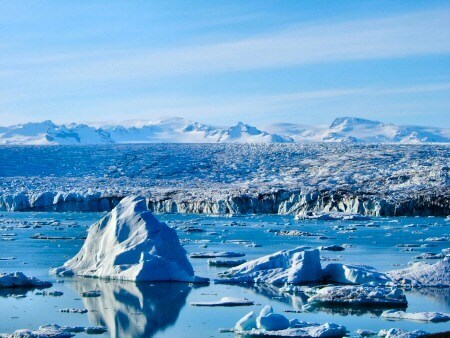Scientists have recorded and identified one of the most prominent sounds of a warming planet: the sizzle of glacier ice as it melts into the sea. The noise, caused by trapped air bubbles squirting out of the disappearing ice, could provide clues to the rate of glacier melt and help researchers better monitor the fast-changing polar environments.
Geophysicist Erin Pettit, a researcher at the University of Alaska, had often heard popping, crackling sounds while out kayaking in the frigid northern waters. The sounds were also picked up by underwater microphones Pettit set up off the Alaskan coast, and at a much louder volume than above the surface.
“If you were underneath the water in a complete downpour, with the rain pounding the water, that’s one of the loudest natural ocean sounds out there,” she said. “In glacial fjords we record that level of sound almost continually.”
While Pettit suspected the din was caused by melting ice, she couldn’t confirm that hypothesis without a more controlled experiment. So she enlisted the help of Kevin Lee and Preston Wilson, acoustics experts from the University of Texas. Pettit sent the Texas researchers chunks of glacier, which they mounted in a tank of chilled water. Lee and Wilson recorded video and audio of the ice as it melted and were able to match sounds on the recording to the escape of bubbles from the ice.
“Most of the sound comes from the bubbles oscillating when they’re ejected,” Lee said. “A bubble when it is released from a nozzle or any orifice will naturally oscillate at a frequency that’s inversely proportional to the radius of the bubble,” he said, meaning the smaller the bubble, the higher the pitch. The researchers recorded sounds in the 1 – 3 kilohertz range, which is right in the middle of the frequencies humans hear.
Scientists have known for decades that the bubbles in glaciers form when snow crystals trap pockets of air and then get slowly squashed down under the weight of more snow. As the snow is compacted it turns into ice and the air bubbles become pressurized. The regular way the bubbles form means that they are evenly distributed throughout the ice, an important characteristic if you want to use the sound intensity of bubble squirts to measure ice melt rate.
While the symphony of melting ice might not carry the same emotional wallop as images, sound still has its own, sometimes very loud, story to tell. Pettit and Lee say they could imagine using hydrophone recordings in glacial fjords to monitor relative changes in glacier melting in response to one-time weather events, seasonal changes, and long-term climate trends. Because sound travels long distances underwater, recording microphones can be placed a safe distance from unstable ice sheets. The audio recordings would complement other measurements of ice melt, such as time-lapse photography and salinity readings.



